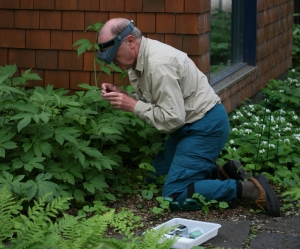By Chris Buddle, Editor of the Canadian Entomologist
———————–
I am pleased to present the “Editor’s Pick” manuscript for the current issue of The Canadian Entomologist. This pick was a paper by Bob Lamb, Patricia MacKay and Andrei Alyokhin, titled “Seasonal dynamics of three coexisting aphid species: implications for estimating population variability”
I had always admired the ongoing work on aphids, spearheaded by Bob and Pat. Their work is always relevant, meticulous, framed in an important and broader ecological context, and they have a ‘model system’ to work with. This is the kind of researcher many more junior entomologists look up to. The current paper is no exception. In this work, Bob and Pat joined up with Andrei Alyokhin and present a careful study of population variability and effectively use this metric to better understand population dynamics over time. For me, I see much value in this approach, and can see how this kind of work could effectively be used in teaching students about how to best describe, understand, and quantify population dynamics. I’m also inspired to see long-term data with arthropods. These kinds of data are so useful, but relatively rare. It’s great to see Bob, Pat and Andrei publish thoughtful and important work using such data. I may also look around some old filing cabinets at my University…
Bob was kind enough to answer a few questions about this work, with input from his co-authors.
What inspired this work?
When Pat MacKay and I were anticipating eventual retirement from paying jobs as entomologists, we decided to begin a study of an aphid population that could be pursued as long as we could walk trails and count aphids. Our goal was to figure out why aphid populations seem to be so unstable. Eventually we wrote up our findings on the stability of one native species over the first 10 years of a study we hope will go on for at least another 10 years. A few years ago we realized we needed comparative data, but were too old to start on a 20-year study of another aphid species. The solution was to write to colleagues who also had long-term data sets, to see if they were interested in looking at their data from this perspective. So far the colleagues we have contacted have been enthusiastic collaborators. The first was Andrei Alyokhin our coauthor on the current paper. He gave us access to 60 years of data on three aphid species. The first paper on the stability of these aphids was published in the Canadian Entomologist two years ago. The current paper extends that earlier work, looking now at how aphid seasonal biology affects our estimates of stability.
What do you hope will be the lasting impact of this paper?
We hope that this paper will help convince other researchers that Joel Heath’s metric, PV, which we use to quantify population variability, is a robust way to quantify one aspect of the stability of populations. If more researchers adopt this metric, ecologists will have a much greater opportunity to apply a comparative approach and identify factors that contribute to stability or instability of populations.
Where will your next line of research on this topic take you?
Pat MacKay and I continue to extend our time series on the abundance of a native aphid, and are now focusing more on the ecological processes that cause our five populations to rise and fall. We also hope to expand our studies of stability to still more aphid species, but also species with very different life histories. At the moment I am working with a colleague, Terry Galloway, University of Manitoba, on several time-series of ectoparasite abundance on birds.
Do you have any interesting anecdotes about this research?
One of the most interesting aspects of the work on aphids from potatoes is the source of the data – 60 years or more of weekly aphid counts. The data for the early years were discovered by Andrei Alyokhin in an abandoned filing cabinet stored in a barn at the University of Maine. Andrei was a new faculty member at the time exploring his research facilities. His predecessors had maintained meticulous records of aphid densities in potato plots since soon after World War II. Andrei was quick to recognize the value of this data, and more importantly recognized the need to go on collecting the data in the same way. The result is an amazing data set, one of the longest continuous records at one location of the dynamics of multi-voltine species.
Lesson 1: newly-hired entomologists should begin their careers by searching old filing cabinets.
Lesson 2: meticulous long-term records can be invaluable, sometime in ways that you might not anticipate.
Lamb R.J., MacKay P.A. & Alyokhin A. (2013). Seasonal dynamics of three coexisting aphid species: implications for estimating population variability, The Canadian Entomologist, 145 (03) 283-291. DOI: 10.4039/tce.2013.1
This post is also available in: English


